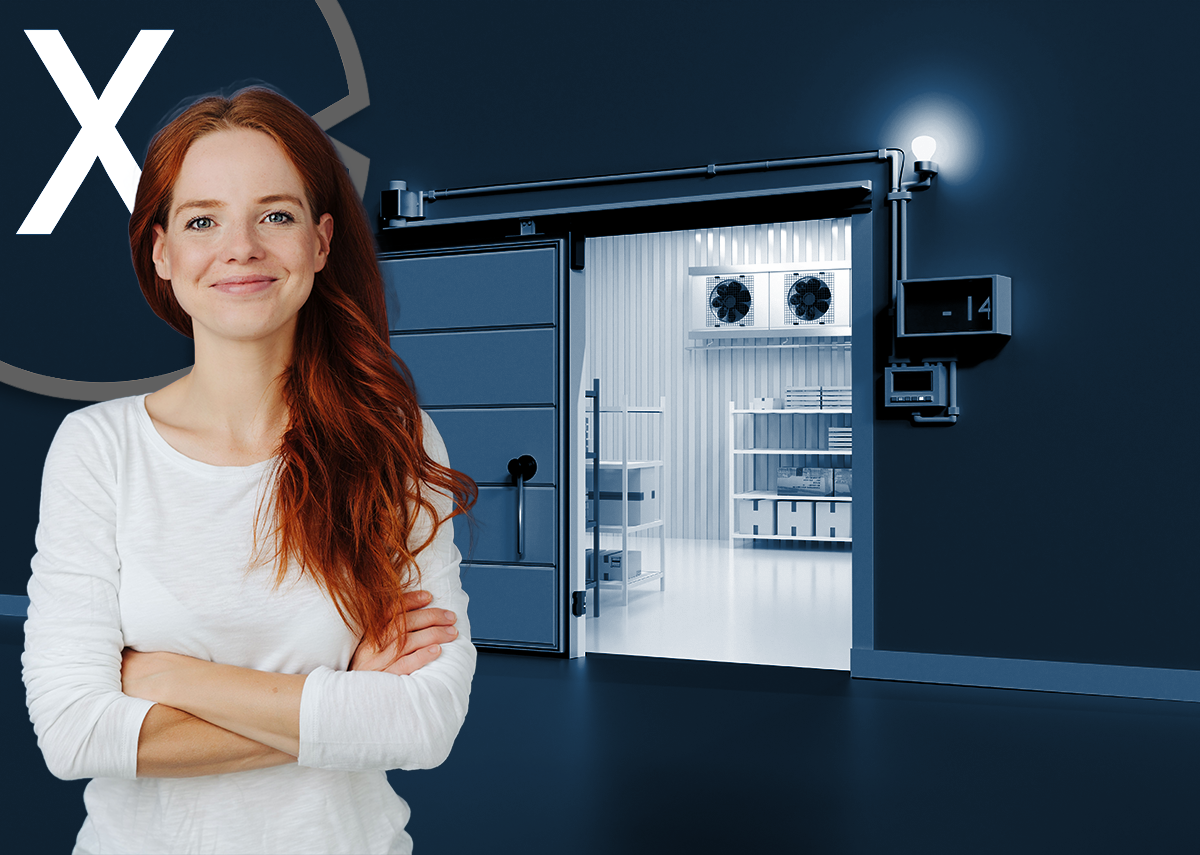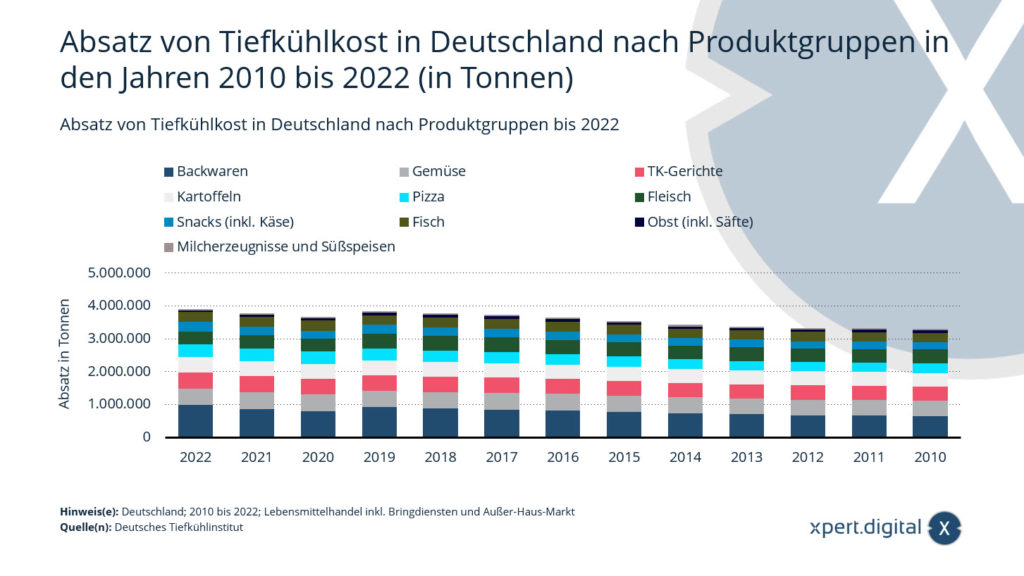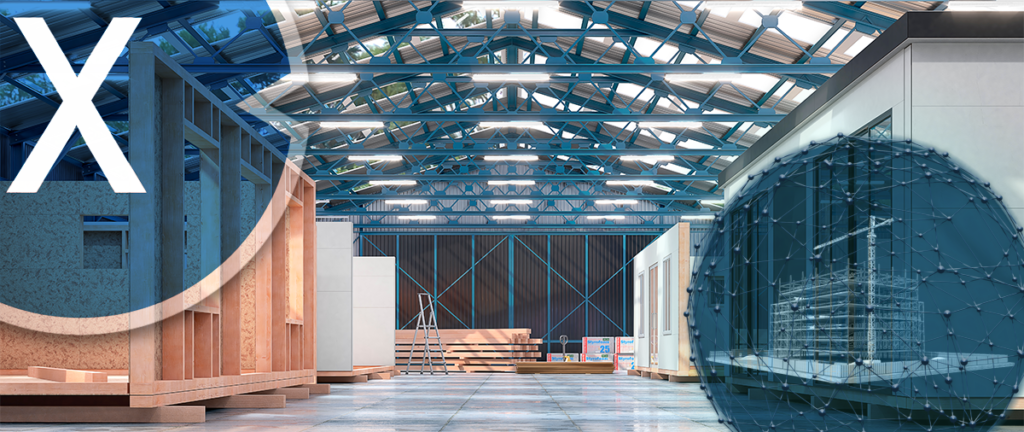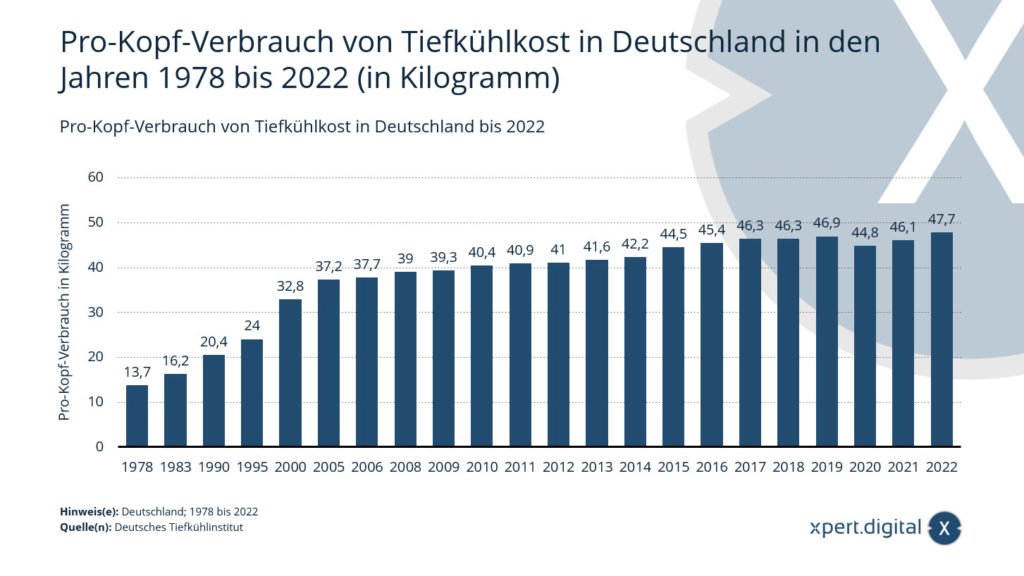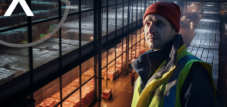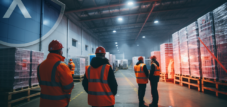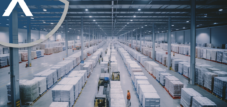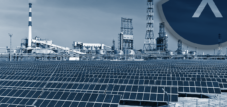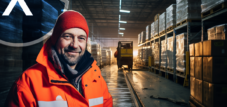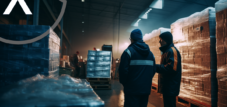Sustainability & refrigerated logistics: Optimizing energy costs in refrigerated and deep-freeze warehouses while reducing CO2 emissions?
Language selection 📢
Published on: October 17, 2023 / Update from: December 7, 2023 - Author: Konrad Wolfenstein
🌿 Sustainability & refrigerated logistics: Optimizing energy costs in refrigerated and deep-freeze warehouses while reducing CO2 emissions?
Sustainability and the reduction of CO2 emissions are now central topics in various industries, including refrigerated logistics. Cold and frozen storage facilities play an important role in the food and pharmaceutical industries, but they are also responsible for significant energy consumption and CO2 emissions. The challenge is to optimize energy costs in these warehouses while minimizing the environmental impact. In this article, we will take a closer look at the different approaches and technologies that can help achieve these goals.
🌡️ Energy consumption and CO2 emissions in cold and frozen storage facilities
Before we delve into the solutions to optimize energy costs and reduce carbon emissions, it is important to understand why these warehouses are so energy intensive and what the environmental impact is.
Refrigerated and frozen storage facilities rely on maintaining low temperatures to ensure the quality and safety of the products stored. This requires the use of cooling systems that continuously consume energy. The main cause of energy consumption in these warehouses is cooling, followed by lighting and ventilation. The use of refrigerants in cooling systems can also lead to significant CO2 emissions.
According to data from the Federal Environment Agency in Germany, 98% of energy-related greenhouse gas emissions consist of carbon dioxide (CO2). This highlights the importance of reducing energy consumption in refrigerated and frozen storage facilities to reduce CO2 emissions.
🔄 Optimization of energy costs in cold and deep-freeze warehouses
Optimizing energy costs in cold and deep-freeze warehouses makes both economic and ecological sense. Here are some approaches and technologies that can help:
1. Energy efficient cooling systems
The use of energy-efficient cooling systems is crucial. Modern technologies enable more precise control of temperature and energy consumption. The systems should also be maintained regularly to maintain their efficiency.
2. Insulation and insulation
Good insulation and insulation of storage buildings reduces heat loss and reduces the energy required for cooling. This can significantly help reduce energy costs.
3. Automation and control systems
Automation technologies and advanced control systems make it possible to monitor and optimize energy consumption in real time. For example, refrigerated and frozen storage facilities can adapt their activities to demand to avoid wasting energy.
4. Renewable energy sources
Integrating renewable energy sources such as solar energy or wind power into the warehouse energy supply system can help further reduce the carbon footprint.
5. Heat recovery
The heat generated during cooling can be used for other purposes, such as heating rooms or producing hot water. This increases efficiency and saves energy.
🌬️ CO2 emission reduction in cold and deep-freeze storage
Reducing CO2 emissions in refrigerated and frozen storage facilities requires a comprehensive strategy. Here are some steps that can help:
1. Sustainable refrigerants
The use of environmentally friendly refrigerants with little or no CO2 potential is an important step. This reduces direct CO2 emissions from the cooling systems.
2. Cold chain optimization
An optimized cold chain that ensures the transport of products at appropriate temperatures prevents unnecessary energy waste and thus indirectly reduces CO2 emissions.
3. Monitoring and reporting
Continuous monitoring of CO2 emissions and their reporting make it possible to track progress and take targeted measures to reduce them.
4. Renewable energy
As already mentioned, the use of renewable energy sources can make a big contribution to reducing CO2 emissions.
🏭 Examples of success from industry
Several companies have already successfully implemented sustainability measures in their cold and frozen storage facilities. Some examples are:
BMW
The company is actively committed to reducing CO2 emissions in its production facilities and has taken measures to reduce resource consumption.
Festo
Festo offers automation products and services that help reduce CO2 emissions and increase energy efficiency.
🌱 Optimizing energy costs and reducing CO2 emissions
Optimizing energy costs and reducing CO2 emissions in cold and deep-freeze storage are important steps towards greater sustainability and environmental protection. This requires cooperation from companies, governments and society as a whole. With the right technologies and strategies, cold and deep-freeze storage can make a significant contribution to addressing global climate challenges. It's time to increase energy efficiency while minimizing our carbon footprint to ensure a sustainable future.
📣 Similar topics
- Sustainable refrigerated logistics: CO2 reduction in warehouses ❄️🌱
- Energy efficient solutions for cold and frozen storage 🌡️💡
- Green refrigerated logistics: Sustainable approaches to CO2 minimization 🌍♻️
- Energy optimization in refrigerated logistics: Lower costs, less CO2 📉🍃
- Refrigerants and CO2 emissions: An environmentally friendly future 🔄🌿
- Automation in cold and deep-freeze warehouses: energy efficiency in real time 🤖🔋
- Renewable energies in warehouses: CO2 reduction through solar energy ☀️🔌
- Heat recovery in cooling logistics: Efficient energy utilization 🔥🏭
- Sustainable cooling systems: reduce CO2 emissions, minimize costs 💰🌎
- Industrial sustainability: examples of success from the storage industry 🏭🌟
#️⃣ Hashtags: #sustainability #cooling logistics #CO2 reduction #energy efficiency #environmental protection
📊 Frozen food in Germany by product group
The development of domestic sales of frozen food in Germany between 2010 and 2022 is of particular interest. In 2022, domestic sales of frozen meat in Germany reached an impressive total of around 384,191 tons. These statistics reflect the dynamic development of this sector in recent years.
🍽️ Frozen food in Germany: A variety of products for every taste
Frozen food is an important part of the German food industry and has a permanent place in consumers' households. The range of products ranges from frozen vegetables to pizza and ice cream, and they are widely available in supermarkets, but also in delivery services and out-of-home catering.
🏭 The German Frozen Institute (dti) and its role in the industry
The German Frozen Institute (dti) plays a central role in the industry. As the interest group for the German frozen food industry, the dti represents the interests of companies along the entire frozen food chain. This includes not only the production of frozen products, but also logistics and trade. The dti is committed to promoting and further developing the frozen food industry in Germany.
📈 The product groups in focus: frozen meat, frozen vegetables, pizza and snacks, ice cream
In recent years, the frozen food market in Germany has developed positively in terms of sales. There are various product groups that influence sales of frozen food in Germany. Here is some important information about these product groups:
1. Frozen meat
As already mentioned, domestic sales of frozen meat reached around 384,191 tons in 2022. This shows that frozen meat is still a popular product in German households. It is often valued for convenience and longer durability.
2. Frozen vegetables
Frozen vegetables are a healthy option for consumers who want to store fresh vegetables for longer. It is also a convenient solution for meal preparation. Sales of frozen vegetables are also likely to make up a significant proportion of total sales of frozen food in Germany.
3. Pizza and snacks
Frozen pizza and snacks are popular options for quick meals or snacks. The variety of flavors and quick preparation have contributed to these products being in high demand in German households.
4. Ice cream
Ice cream is a classic frozen product and is very popular with young and old. Sales of frozen ice cream are also likely to account for a significant share of total sales of frozen food in Germany.
🍽️ Frozen food in German food culture
It is interesting to note that sales of frozen food in Germany are not only limited to the grocery store. It also includes delivery services and the take-out market. This means that frozen products are served not only in supermarkets, but also in restaurants, takeaways and other food establishments. This shows the diverse possible uses of frozen food in German food culture.
🚀 Factors driving the increase in frozen food sales
The increase in frozen food sales can be attributed to various factors. This includes:
Convenience
Frozen foods offer easy and quick meal preparation, which is particularly attractive to people with little time or cooking skills.
Longer shelf life
Frozen products have a longer shelf life than fresh products, which helps reduce food waste.
diversity
The variety of frozen products available appeals to a wide range of tastes and dietary needs.
Health awareness
Some frozen products, particularly frozen vegetables, are considered a healthier alternative to fresh produce because they retain their nutrients while frozen.
Changes in eating behavior
The trend toward more snacking and home-cooked meals, boosted by the COVID-19 pandemic, may also have boosted frozen food sales.
🌟 Quality and diversity in focus
It is also worth mentioning that frozen food in Germany has increasingly focused on quality and variety in recent years. This means consumers can find a wide selection of high-quality frozen products to suit their needs and preferences.
Sales of frozen food in Germany grew continuously between 2010 and 2022, with frozen meat, frozen vegetables, pizza, snacks and ice cream being among the most popular product groups. This trend is driven by convenience, longer shelf life and variety of products, as well as changes in consumer eating habits. The German Frozen Institute plays an important role in promoting and supporting this thriving industry.
📣 Similar topics
- Frozen food in Germany: A success story 🍕🍦
- Frozen meat in Germany: More popular than ever 🥩
- Healthy options: frozen vegetables on the rise 🌽🥦
- Quick meals: The world of frozen pizza and snacks 🍕🍟
- Ice cream: A sweet treat from the freezer 🍨❤️
- The German Frozen Institute: Driving force of the industry 🏭
- Why frozen food is booming in Germany 📈💥
- Convenience and variety: The success factors of frozen products 🛒🌟
- Frozen food in German gastronomy: A culinary diversity 🍽️🏨
- Frozen food and changing eating habits: The impact of COVID-19 🍽️🦠
#️⃣ Hashtags: #Frozen Food #Germany #Food #Eating Behavior #Frozen Meat #Frozen Vegetables #Pizza #Ice Cream #Convenience #Variety
📣 Energy-related renovation and new construction, consulting, planning and implementation for industry, retail and municipalities
Our experienced team will support you in optimizing your buildings to reduce energy consumption and promote sustainable energy use with photovoltaics. We analyze your individual needs and create tailor-made concepts that make sense both economically and ecologically. Regardless of whether it is about the energy-efficient renovation of existing buildings or the construction of new energy-efficient structures, we are at your side. Industrial facilities, retail buildings and municipal facilities can reduce their energy costs and reduce environmental impact while improving the comfort and efficiency of their buildings through our tailored solutions.
👨🏻 👩🏻 👴🏻 👵🏻 Energy-saving renovation and new construction, advice, planning and implementation for private households
We offer comprehensive support for private households in the energy-efficient renovation and construction of new buildings with photovoltaics. Our experienced team is at your side to help you advise, plan and implement your sustainable energy solutions. We analyze your energy consumption, identify savings potential and develop tailor-made concepts to improve your energy efficiency. From improving building insulation to installing energy-efficient windows and doors to installing photovoltaic and solar systems - we accompany you step by step to make your home more energy efficient and environmentally friendly. Trust in our expertise and benefit from the numerous advantages that energy renovation and the use of renewable energies offer you. Together we will create a sustainable future for your home.
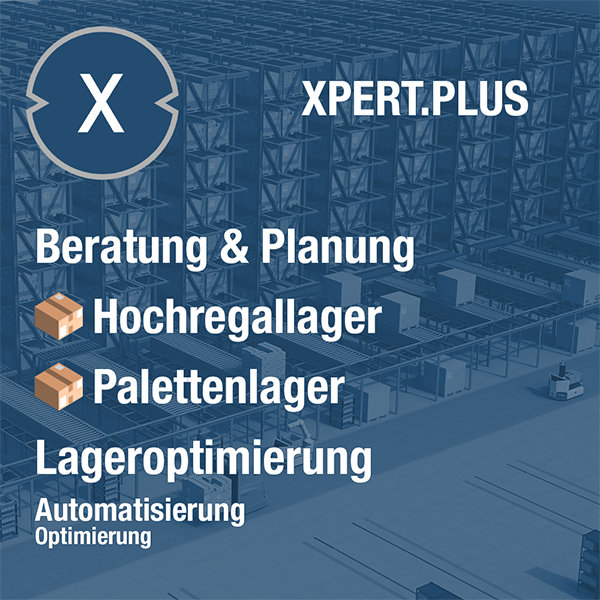
Xpert.Plus warehouse optimization - high-bay warehouses such as pallet warehouses consulting and planning
🌿 Sustainability in refrigerated logistics: How can you reduce CO2 emissions?
Sustainability in refrigerated logistics is of increasing importance as food transport and storage make a significant contribution to the world's CO2 emissions. This article explores various strategies and technologies that can help reduce the environmental impact of refrigerated logistics and minimize CO2 emissions.
1. 🚚 Optimization of transport routes and load factors
Efficient route planning and optimization of load factors are crucial to reducing the fuel consumption of refrigerated trucks. Modern logistics software can help find the best routes and ensure that trucks and vans are optimally loaded.
2. ⚡ Use of electric vehicles
Electric vehicles are becoming increasingly important in refrigerated logistics. They do not produce any direct emissions and therefore contribute significantly to reducing CO2 emissions. Companies are increasingly investing in electric vans and trucks to make their transport fleets more sustainable.
3. 🌱 Alternative drive technologies
In addition to electric vehicles, other alternative drive technologies such as hydrogen fuel cells and natural gas are also an option. These technologies have the potential to further reduce the carbon footprint of refrigerated logistics.
4. ❄️ Improvement in cooling technology
Cooling technology has improved significantly in recent years. Efficient refrigeration equipment and systems can help reduce energy consumption while maintaining the quality of the food being transported.
5. ☀️ Use of renewable energy
The use of renewable energies in refrigerated logistics is an important step towards reducing CO2 emissions. Solar panels on warehouses and electric vehicle charging stations can utilize green energy sources.
6. 📦 Packaging optimization
Lighter and more environmentally friendly packaging can reduce the weight of transported goods, which in turn reduces fuel consumption. Additionally, reusable packaging and containers should be considered.
7. ❄️ Cold chain management
Effective cold chain management is essential to minimize food loss. Precise temperature monitoring and control can reduce waste and improve sustainability.
8. 📚 Training and awareness raising
Training and education programs for logistics employees can help to use resources more consciously and promote sustainable practices in refrigerated logistics.
9. 🌍 Policy measures and regulation
Governments and international organizations play a crucial role in promoting sustainable practices in refrigerated logistics. This can be achieved by setting emissions standards and incentivizing environmentally friendly transportation methods.
10. 🌐 Innovative technologies such as the Internet of Things (IoT)
IoT enables real-time monitoring of cold chains and vehicles. By integrating sensors and data analytics, companies can receive precise information about the condition of food and the efficiency of their fleets.
📣 Similar topics
- Sustainable refrigerated logistics: ways to reduce CO2 🌍
- Electric vehicles in refrigerated logistics: the future of delivery ⚡
- Hydrogen and natural gas: New drives in refrigerated logistics 🔋
- Efficient cooling technology: energy savings and quality 🌡️
- Green energy in refrigerated logistics: solar and electric ⚡☀️
- Sustainable packaging: easier to transport, less CO2 📦
- Cold chain management for less food waste 🍏
- Training for sustainable refrigerated logistics: Raise employee awareness 📚
- Politics and regulation in refrigerated logistics: environmental standards 🌿
- IoT in refrigerated logistics: real-time monitoring and efficiency 📡
#️⃣ Hashtags: #SustainableLogistics #CO2Reduction #Electric Vehicles #Cooling Technology #GreenEnergy #Packaging Optimization #Cold Chain Management #Sustainability Training #Environmental Regulation #IoTinLogistics
➡️ Reducing CO2 emissions in refrigerated logistics requires a holistic approach in which technology, processes and awareness of sustainability play an important role. Companies and governments around the world are working together to make this industry more environmentally friendly to mitigate climate change and ensure a sustainable future.
📊 Per capita consumption of frozen food in Germany
The per capita consumption of frozen food in Germany has changed significantly between 1978 and 2022. In 1978, the average consumption per person was just 13.7 kilograms. But in the decades that followed, the frozen food industry experienced a significant boom.
📈 Year 2022: An impressive 47.7 kilograms
In 2022, the per capita consumption of frozen food in Germany reached an impressive 47.7 kilograms. This shows a remarkable increase compared to the late 1970s. But what exactly falls under the term “frozen food”?
🍽️ Frozen foods cover a wide range of foods
Frozen foods include a wide range of foods that are frozen and stored in this state. This includes:
1. Frozen vegetables and fruits
This includes not only a variety of vegetables, but also frozen fruits and even fruit juices.
2. Meat and fish products
Meat and fish are often frozen to extend their shelf life. Consumers can enjoy a variety of meat and fish dishes.
3. Pizzas and frozen meals
Frozen pizzas and ready meals are popular with many people because they can be prepared quickly.
4. Baked goods
From frozen rolls to croissants, baked goods are also part of the frozen food category.
5. Side dishes and snacks
This includes French fries, onion rings and other side dishes that are easy to find in the freezer. Various snacks, such as chicken nuggets, are also represented in this category.
6. Potato products
Frozen potato products such as French fries, hash browns and potato pancakes are popular side dishes.
Notice
It is worth noting that ice cream is not included in these statistics as it is considered a separate category.
📈 Reasons for the increase in consumption
The increase in per capita consumption of frozen food in Germany can be attributed to various factors. One of them is the growing lack of time among many consumers. Frozen products offer a convenient way to prepare meals quickly, which is especially appreciated in our busy world.
🌟 Modern technology and quality improvements
Additionally, improvements in technology and food processing have significantly increased the quality and variety of frozen foods offered. Modern frozen products are often of high quality and taste fresh.
🏢 The German Frozen Institute (dti)
The German frozen food industry is represented by the German Frozen Institute (dti). This organization plays an important role in the industry and represents the interests of companies along the entire frozen food chain. This includes manufacturers, logistics companies and retailers.
📏 Standards and quality assurance
The dti advocates for standards in the frozen food industry and promotes communication and the exchange of information between the various players. This helps to ensure the quality and safety of frozen products in Germany.
📈 Booming frozen food industry
In recent years, the frozen food industry in Germany has experienced remarkable development. Sales of frozen products have been growing steadily, driven by increasing consumer demand for convenient and tasty solutions for their meals. The market for frozen pizzas and ready meals is booming in particular.
🌍 Sustainable packaging
Another interesting aspect is the packaging of frozen foods. Sustainability and environmental friendliness are increasingly important topics. Manufacturers and packaging companies are working on solutions to package frozen products safely, flexibly and environmentally friendly. This includes using recyclable materials and developing packaging that reduces the environmental footprint.
📣 Similar topics
- 🍽️ The development of frozen food consumption in Germany
- 🥦 Frozen vegetables and fruits: Popular options
- 🍕 The renaissance of frozen pizza
- 🌿 Healthy eating with frozen food
- 🌍 Sustainable packaging in the frozen food industry
- 🏭 The German Frozen Institute and its role
- 🍗 Meat and fish products in the frozen sector
- 🥖 The variety of frozen baked goods
- 🍟 French fries and Co.: Popular potato products
- ⏱️ Lack of time and the rise of frozen foods
#️⃣ Hashtags: #FrozenFood #Food #ProHeadConsumption #Sustainability #GermanTief Kühlinstitut
The per capita consumption of frozen food in Germany increased significantly from 1978 to 2022. This reflects changes in consumers' eating habits and lifestyles. The frozen food industry has successfully adapted to these needs, offering a wide range of high-quality and convenient foods. The German Frozen Institute plays an important role in representing the interests of the industry and in promoting quality standards.
🏭 Optimizing energy costs in cold and deep-freeze warehouses
Optimizing energy costs in cold and deep-freeze warehouses is a crucial aspect of modern warehouse logistics. This section presents best practices and innovative solutions to increase energy efficiency in these facilities while reducing costs.
📝 1. Introduction
Cold storage and deep-freeze storage play a central role in the food and pharmaceutical industries, as well as in other industries that need to store sensitive products. However, these warehouses are also responsible for significant energy consumption. Optimizing energy costs in such facilities is therefore of great importance.
🌟 2. Energy optimization best practices
Temperature management
Precise control of storage temperatures is crucial. Modern systems allow the temperature to be adjusted as needed to minimize energy consumption.
Insulation and sealing
Well-insulated warehouses and doors help reduce heat loss and reduce energy consumption.
Efficient lighting
LED lighting systems are more energy efficient than traditional lamps and can significantly reduce electricity consumption.
Load management
The simultaneous commissioning of refrigerators and freezers should be avoided in order to prevent peak loads.
🚀 3. Innovative solutions
Automated warehouse management systems
These systems not only optimize storage space utilization, but also enable efficient use of refrigeration and freezing capacities.
Energy efficient cooling technologies
New refrigerants and technologies, such as compression-free cooling systems, help reduce energy consumption.
Data analysis and AI
By analyzing data, warehouse operators can identify and optimize energy consumption patterns. Artificial intelligence can help make predictions and manage energy consumption.
💰 4. Economic benefits
Optimizing energy costs in cold and deep-freeze warehouses offers not only ecological but also financial advantages. Reducing energy consumption results in lower operating costs and contributes to long-term profitability.
🌐 5. Challenges and future outlook
Switching to energy-efficient solutions requires investments and technological adjustments. Nevertheless, optimizing energy costs in cold and deep-freeze warehouses will play an even more important role in the future as the requirements for sustainability and cost efficiency increase.
🔍 6. Optimization
Optimizing energy costs in refrigerated and frozen storage facilities is a complex but extremely important topic. By implementing best practices and integrating innovative technologies, companies can not only reduce their environmental impact but also increase their competitiveness. It’s time to address the challenges and invest in a sustainable future for warehouse logistics.
📣 Similar topics
- Energy efficiency in cold and frozen storage: Best practices and innovations 🌡️
- Sustainable warehouse logistics: reducing energy costs and environmental impact 🌿
- Cold and deep-freeze storage: tips for optimizing energy efficiency 💡
- Energy saving in the food and pharmaceutical industries 🍏💊
- Innovative technologies for cold-sensitive storage 🌐
- Reduce costs and save energy in warehouses ❄️💰
- Challenges and opportunities in energy optimization 🧩
- Future outlook: Sustainability and competitiveness in warehouse logistics 🚀
- Data analysis and AI in warehouse energy efficiency 📊🤖
- Economic advantages through energy cost optimization 📈💶
#️⃣ Hashtags: #energy efficiency #warehouse logistics #sustainability #innovations #cooling technology
We are there for you - advice - planning - implementation - project management
☑️ Xpert.Plus - logistics consulting and logistics optimization
☑️ Industry expert, here with his own Xpert.Digital Industry Hub with over 1,500 specialist articles
I would be happy to serve as your personal advisor.
You can contact me by filling out the contact form below or simply call me on +49 89 89 674 804 (Munich) .
I'm looking forward to our joint project.
Xpert.Digital - Konrad Wolfenstein
Xpert.Digital is a hub for industry with a focus on digitalization, mechanical engineering, logistics/intralogistics and photovoltaics.
With our 360° business development solution, we support well-known companies from new business to after sales.
Market intelligence, smarketing, marketing automation, content development, PR, mail campaigns, personalized social media and lead nurturing are part of our digital tools.
You can find out more at: www.xpert.digital - www.xpert.solar - www.xpert.plus



